The influence of borehole arrangement of soundless cracking demolition agents (SCDAs) on weakening the hard rock
2021-04-08WeiTangChengZhaiJizhaoXuYongSunYuzhouCongYangfengZheng
Wei Tang,Cheng Zhai,Jizhao Xu,Yong Sun,Yuzhou Cong,Yangfeng Zheng
Key Laboratory of Coal Methane and Fire Control,Ministry of Education,China University of Mining and Technology,Xuzhou 221116,China State Key Laboratory of Coal Resources and Safe Mining,Xuzhou 221116,China School of Safety Engineering,China University of Mining and Technology,Xuzhou 221116,China
Keywords:Coal mine Soundless cracking demolition agents Hard roof Numerical simulation Borehole angle Weakening unit
ABSTRACT The hard roof difficult to collapse easily causes gas accumulation,which threatens the production safety of coal mine.Therefore,roof pre-cracking is required.Although blasting and hydraulic fracturing can also crack the roof,blasting can easily induce rock bursts,whereas hydraulic fracturing needs complex equipment.In contrast,soundless cracking demolition agents(SCDAs)with noise-free,dust-free,and safe characteristics have obvious advantages.The main component of SCDA is calcium oxide,which reacts with water to produce higher expansion pressure.In this paper,focused on the angles of the borehole,the effect of SCDA is analyzed by numerical simulation based on Pingdingshan coal mine.The research results showed that the azimuthal angle α (between borehole projection and the roadway direction) does not significantly affect the efficacy of SCDAs,whereas the influence of borehole elevation angle β is far more significant than that of the azimuthal angle.Therefore,the angle β is a dominant factor influencing the effect of SCDAs.Based on different effects of SCDAs at different angle of boreholes,the weakening unit was established,so the SCDAs could give full play to roof fracturing.Moreover,field tests validated the importance of borehole angle on weakening the hard roofs.
1.Introduction
The hard roof with high strength is difficult to collapse in coal mine,which threatens production safety [1,2].At present,there are various methods of weakening hard roofs of mining face[3-7].However,research on hard hanging roof at the corner of mining face is sparse.After the hard roof is caved,the arcuate triangular block is formed at the corner,as shown in Fig.1[8,9],which is in the state of stress reduction.Because of the high strength,the arcuate triangular block is extremely hard to cave timeously.The presence of multiple arcuate triangular blocks prevents the coal roadway in goaf from being completely backfilled with broken rock,with the constant advance of the mining face.The arcuate triangular blocks at the lower corner lead to air leakage of the goaf while those at the upper corner contribute to gas emissions.To prevent the formation of arcuate triangular blocks during roof caving,it is necessary to weaken and fracture the hard roof at the corners in advance before driving mining face.Therefore,the weakened triangular blocks at corners can be caved immediately after mining,which guarantees safe production in such coal mines.
Existing rock fracturing methods mainly include explosive blasting,hydraulic fracturing,and high-pressure gas fracturing[10-14].In terms of explosive blasting,rocks are broken by highpressure gas and shock waves generated during explosion.In this process,chemical reaction is strong,and it is hard to realise controllable pre-cracking and weakening of roofs.Moreover,the explosion flames are likely to detonate gas accumulated at the upper corner.For hydraulic fracturing,the rock mass is fractured by high-pressure water.It calls for huge equipment systems and complex technological processes.High-pressure gas blasting is applied to fracture rock mainly through liquid CO2phase transition.By using a fracturing device,liquid CO2is gasified to generate high-pressure gas,realising the fracturing of rock mass.This method shows poor controllability and the instantaneous release of high-pressure gas poses a significant risk.Of course,many scholars are exploring new methods recently.For example,Huang et al.[15]and Shang et al.[16,17]have studied microwave-assisted fragmentation;Wu et al.[18]and Qin et al.[19]have studied method of freezing rock with liquid nitrogen,and they all make important discoveries.
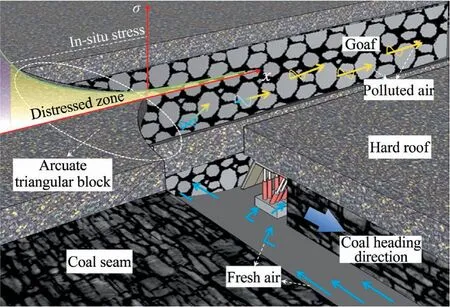
Fig.1.An arcuate triangular block.
By contrast,soundless cracking demolition agents (SCDAs) are easy to prepare and undergo a stable,easy-to-control chemical reaction which is no-noise,dust-free,and safe during rock fracturing [20].SCDAs have been widely applied in subway construction,slope engineering,and bridge and wharf construction.In recent years,many scholars have explored the use of SCDAs.After adding viscosifiers into SCDAs,De Silva et al.[21]experimentally investigated the mechanical properties and analysed microstructures and mineral compositions of the improved SCDA during hydration through various methods,including acoustic emission (AE),scanning electron microscope (SEM),and X-ray diffraction (XRD),and they concluded the material proportioning in water-rich environment,at which the SCDA shows its optimal effect.Natanzi et al.[22]measured the changes of hydration heat and temperature of SCDA at different ambient temperatures (2-19 °C) and found the relationships of the development of expansive pressure and the peak hydration heat of SCDA with ambient temperature.Xu et al.[23]analysed the crack propagation and changes in AE energy of different samples under the effect of SCDAs by using AE system and fractal dimension method.Tang et al.[24]investigated different proportions of calcium oxide,naphthalene series water reducers,sodium gluconate,and Portland cement in SCDAs through use of an orthogonal experiment and found that the optimal proportion of the four compositions was 90:3:5:7.After placing SCDAs in a water bath at 10 °C,Laefer et al.[25]evaluated the influences of the diameter,volume,and heat transfer properties of boreholes on SCDAs by analysing the hydration heat,expansive pressure,heat transfer,and volumetric expansion of steel pipes with different diameters.
Many scholars [22,24,25]have explored the compositions of SCDAs and the change of various performances (such as pressure and temperature)during chemical reaction.However,there is little research on the application of SCDAs in underground coal mines.Many factors including moisture content,stress field,borehole diameter and length,filling degree,etc.,can influence the reaction of SCDA.However,for a specific coal mine environment,the angle of borehole is a primary factor.At present,when SCDAs are used to crack the roof in underground coal mines,boreholes are generally drilled perpendicular to the roof and their spacing is subjectively determined and lacks support from scientific data.If the boreholes are not reasonably distributed,it not only cannot exert the expansive pressure of SCDAs,which fails to realise the expected fracturing effect,but also increases engineering workload and cost.Actually,due to the absence of free surfaces,the boreholes perpendicular to the roof are not able to give full play to the optimal effect of the SCDAs.The more parallel the boreholes are to the roof,the better the cracking effect.This is because borehole parallel to the roof means the distance between the bottom of the borehole and the free surface of roof is short.However,in order to crack the deep roof,it has to increase the angle.Therefore,it is necessary to explore the influence of different borehole angles on the effect of SCDAs.
Based on the air return roadway in 21100 mining face of No.2 coal mine (Pingdingshan Shares),influence of boreholes angles on the effect of SCDAs in fracturing rock mass was investigated by using FLAC3Dnumerical simulation software.The authors have established the technical thinking of ‘‘step-by-step weakening,spatio-temporal coordination,overall weakening”.The‘‘weakening units”for hard hanging roof at corners were established and subjected to engineering verification in situ.
2.Rock breaking mechanism and expansive pressure testing of SCDAs
Since the introduction of SCDA in the 1960s,many studies have been conducted about their expansion mechanism [26-29].SCDA consists of calcium oxide and other chemical reagents,of which calcium oxide content exceeds 80%.Fig.2a shows the expansion stress distribution of rock mass when SCDA reacts.The expansive pressure of SCDAs was generated mainly due to the production of calcium hydroxide after chemical reaction (CaO+H2O →Ca(OH)2+63.6 kJ/mol).The molecular volume expanded by about 98% after transformation from CaO to Ca(OH)2.On this condition,by using added chemical expansive agents,the expansive pressure of SCDAs exceeded 50 MPa and that of efficient SCDAs even reached 100 MPa [30,31].
For rock mass in roofs,the diameter of boreholes in underground coal mines can be thought to be infinitesimally small,so it can be supposed that rock mass is an infinite elastomer.Mechanical analysis of the effect of SCDAs on a rock mass is shown in Fig.2b [24,32].
The expansive pressure of SCDAs rapidly reduced with increasing distance.A micro-unit at distance r from the centre of the borehole was selected to perform stress analysis.According to the radial stress equilibrium,the equilibrium differential equation of micro-unit can be attained.

where σris the radial stress produced by SCDA;σθthe tensile stress which is perpendicular to the swelling force direction;r the distance from the micro-unit to the centre of the borehole;and θ the centre angle of the micro-unit.On condition of ignoring the small second-order quantity drdσrthrough calculation,Eq.(2) can be obtained.

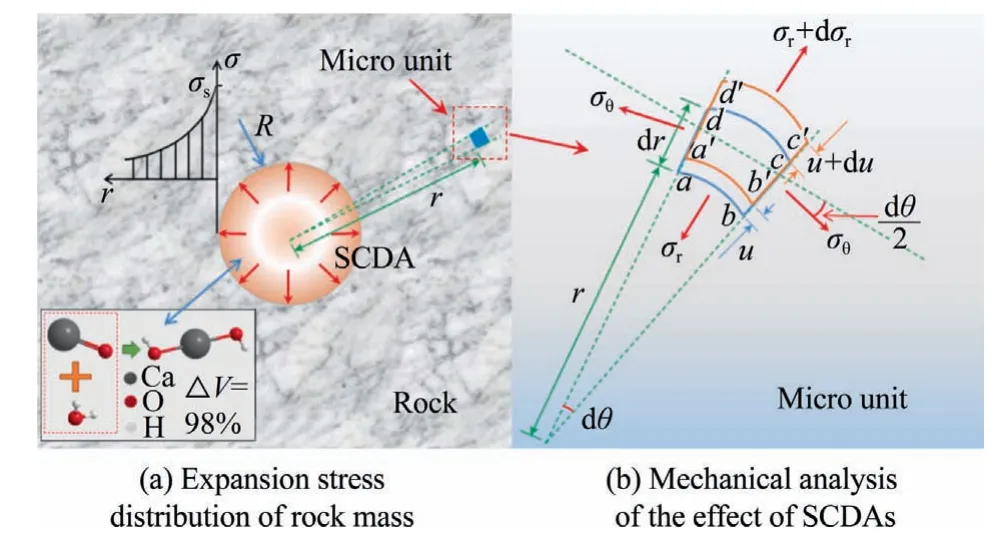
Fig.2.Schematic diagram of stress analysis.
By transforming curved quadrangle abcd into a’b’c’d’,the radial deformation εrand circumferential deformation εθof the microunit can be calculated as follows.

By synchronously calculating the equilibrium equation(Eq.(2)),geometric equations (Eqs.(3) and (4)) as well as Hooke’s law,the following results can be acquired.

where rinand routare the internal and external radiuses of the micro-unit to the centre of the borehole,respectively;and σSthe expansive pressure of SCDAs.The SCDAs explored in the study were improved by B-type packaged reagents (applicable to the ambient temperature of 25-35°C),which produced by CUMT Blasting Technology Co.,Ltd.The expansive pressure of SCDAs was measured by conducting tests for strains of steel pipes [33].The outer diameter(OD),inner diameter (ID),and length of the seamless steel pipe were 48,42,and 500 mm,respectively.The SCDA used in this study is wrapped in copy paper,so the moisture content of SCDA after immersion in water can be determined by weighing method.After 2 min soaking,the moisture content of SCDA is about 26%,and then the SCDA cartridge was tamped in the seamless steel pipe.This charging process is similar to that in field test.By utilising DH3817 strain gauges,the radial strain εxand axial strain εzin the steel pipe were recorded.Furthermore,the expansive stress σSof the SCDA was calculated according to Eq.(7) [33].

where E is the elastic modulus;a and b the ID and OD of the seamless steel pipe,respectively;and μ the Poisson’s ratio.The curve of expansive stress is calculated according to Eq.(7).SCDA was slowly reacted within the first 3600 s and little or no expansive pressure was generated.The effective reaction time was 6-7 h,and the maximum expansive pressure could be up to about 60 MPa.Ignoring the slow reaction stage,the stress curve was fitted with an exponential function σS=-123.8exp(-t/5119.8)+59.8 where t is the test time in s.
3.Numerical simulation
3.1.Research background
The No.2 coal mine of Pingdingshan Shares is located in Henan Province,China,in which the roof of the 21100 mining face is of high strength.Because of the obvious advantages of SCDA,it is decided to use SCDA to pre-crack and weaken the roof of the coal roadway at a position 10 m in front of the mining face.According to geological exploration data,the buried depth of the coal seam is+72 to+145 m,and the corresponding ground elevation is+600.34 to+613.75 m.The vertical stress of the coal seam is the intermediate principal stress with a magnitude of 13.3 MPa,the maximum principal stress is basically the same as that in the direction of the roadway with a magnitude of 19.6 MPa,and the minimum horizontal stress is 11.2 MPa perpendicular to the roadway.The immediate roof was grey limestone with a mean average thickness of 5.1 m,which is difficult to cave.After field sampling,key mechanical parameters of the limestone were measured in the laboratory (Table 1).
3.2.Numerical simulation schemes
In general,the difference of particle size is required not to be too large in PFC simulation software.The borehole radius is only 0.02 m in this test,and the side length of the model is 10 m,which will lead to a large number of particles in the model and increase the calculation time,moreover 33 numerical models have been established in this experiment.Discrete element software like 3DEC is more suitable for exploring the role of joints.FLAC3Duses the finite difference method and a hybrid discrete algorithm,so it can accurately simulate the plastic flow of the unit and is widely used in geotechnical engineering[34-38].Based on the above reasons,FLAC3Dwas chosen in this study.FLAC3D5.0 provides multiple constitutive models,in which a Mohr-Coulomb constitutive model was generally applied in geological strata.In this work,a Mohr-Coulomb constitutive model was adopted.
The angle of boreholes was determined by two directions i.e.α and β (Fig.3a).α refers to the azimuthal angle between the projection of the borehole on horizontal plane xy and the xaxis,while β denotes the drilling elevation angle between the projection of the borehole on the horizontal plane and the borehole.The values of α and β were both constrained by conditions such as operating conditions of the roadway and practical drilling range of the drilling rig.Therefore,optimizing the drilling angle can make the SCDA play a better role and reduce the workload.
Although numerical calculation based on FLAC3Dis widely acknowledged,it is not convenient to pre-process (establishment of model)the model.In this work,it is necessary to establish many models to explore the influence of the borehole angle on the effect of SCDAs.Thus,the mesh generator built-in FLAC3Dwas not applied.All models are built with Rhino and meshed with Griddle to ensure the same mesh gradient,and then the models are imported to FLAC3Dfor calculation.The established model is shown in Fig.3b.The cubic model had a side length of 10 m,in which the length and diameter of the borehole were 2 and 0.04 m,respectively.The stresses sxxand syyin the horizontal plane were initialised to 19.2 and 11.7 MPa,respectively.After the roadway was excavated,the vertical stress on the roof within a certain range was released and the expansive stress developed mainly along the horizontal direction.Therefore,the influence of vertical stress was ignored in the model.The front,back,left,and right sides of the model were set as rolling boundaries,that is,they were allowed to slide while not being allowed to generate normal displacement.The bottom was set as a fixed boundary,that is,it was not allowed to move at any direction.And the top surface was set as a free boundary.
3.3.Simulation process
The parameters in the Mohr-Coulomb constitutive model in FLAC3Dthat need assignment include bulk modulus (K),shear modulus(G),cohesion,tensile strength,and internal friction angle.According to the governing equations K=E/[3(1-2μ)]and G=E/[2(1+μ)],the bulk modulus and shear modulus of limestone are 31.06 and 16.02 GPa,respectively.The process of numerical simulation was divided into the following steps.
(1) After establishing the model,the authors assigned values to parameters,set boundary conditions,and realised the initial stress equilibrium state of the model through calculation.
(2) Boreholes were excavated.The excavation of boreholes did not significantly affect the model,so it was a one-time excavation process,in which the drilling time was not considered.Afterwards,the stress equilibrium of the model was realised through calculation.

Table 1 Physical parameters of the immediate roof (limestone).

Fig.3.Borehole angles and FLAC3D model.
(3) An expansive stress was applied in the inner of boreholes.Owing to the purpose of the study was to explore the damage caused by the expansive stress generated by SCDAs on the surrounding rock,it was necessary to initialise the speed,displacement,and plastic state of each node in the model before applying the expansive stress.
Afterwards,according to the stress curve of SCDA,the loading process was conducted in 2000 steps.Each experimental model was calculated according to the aforementioned steps.It is worth noting that the expansive stress on the borehole wall may not completely follow the change of stress measured by steel pipe strain experiment due to different material properties.However,in the environment of high horizontal stress in deep rock,the authors assumed that the SCDA can still reach the maximum expansion stress measured by experiment and the stress followed the same change trend.Therefore,such stress boundary conditions can ensure that the stress changes on the borehole wall at different angles are consistent.
4.Analysis of results
4.1.Influence of angle α on the effect of SCDAs
The angle α is the azimuthal angle between the projection of boreholes on the horizontal plane and the x-axis.Exploring the influence of angle α mainly aims to clarify the relationship between the boreholes and the horizontal stress direction.Due to the symmetry of the model,five angles α were selected in the range 0° to 90°,i.e.0°,25°,45°,65°,and 90°,respectively.Moreover,the values of β were 25°,45°,and 65°.On this condition,the influences of angle α on the effect of SCDAs at low,medium,and large drilling elevation angles were separately explored.In the study,15 models were established.
Fig.4 shows the nephograms of displacements of upper surfaces of the 15 models.In Fig.4,the white solid lines denote the projection of the borehole on the upper surfaces of the models.It can be seen that rock mass moved mainly along the projection direction of the borehole.For a given β,the change in α did not significantly affect the range of displacement of the rock mass.At α=0° and 90°,that is,the direction of the borehole was parallel or perpendicular to the direction of horizontal stress,the displacements of the two sides of white solid lines were symmetric.However,the stress(19.2 MPa) on the model in the x-direction was higher than that(11.7 MPa) in the y-direction.Thus,the range of displacements of the model at α=90° was greater than that at α=0°,which was easier to be observed at β=65°.For α=25°,45°,and 65°,the displacements of the two sides of the projection of the borehole were all asymmetric.It can be seen from Fig.4 that the range of displacement of rock mass at the B side of the borehole was larger than that at the A side,which was more significant with the increase of β.The reason is that the stress in the x-direction is higher than that in the y-direction,so that the nephogram of displacement is slightly extended in the y-direction.By taking α=45°as an example,the displacement of rock mass within black dotted box developed to the positive direction of y,while the displacement of the borehole within the red dotted box propagated in the negative direction of y.Such changes indicate that the directions of horizontal stress have an effect on the SCDA,but the influence is not very great.At different drilling elevation angles,the displacement showed similar behaviour with changes in α.
In order to quantify the influence of angle α on SCDA,the displacements on the white solid lines in Fig.4 are obtained.Since the displacement difference is very small at the same angle of β,the range where the displacement exceeds 0.001 m,represented by l0,is selected for comparison,as shown in Fig.5.It can be seen from Fig.5 that on the premise of having a given β,the change of α insignificantly influenced the displacement of rock mass.Through the partial enlargement of Fig.5a,one can know,at β=25°,the corresponding distances l0,in which the displacements of the five models exceeded 0.001 m,were 0.264,0.268,0.274,0.277,and 0.294 m,respectively.At α=0°,l0was minimised and it increased with increasing α,in which the maximum growth in l0was 11.36%,since the larger stress in x-direction can hinder rock deformation more.The same trend is also shown in Fig.5b and c.At β=45°,l0did not change significantly,with maximum increases of only 4.81%.At β=65°,l0was about 0.07 m,with a maximum change of 15.15%.
The failure of rocks can be characterised by plastic zones in FLAC3D[39].Fig.6 shows the distributions of three-dimensional plastic zones and plastic zones in the upper surface of different models at β=25°.The red and green units were separately subjected to shear failure and tensile failure.It can be seen in Fig.6 that the shear failure mainly appeared on the surface of the model and the internal wall of the borehole,and units far from the borehole were subjected to tensile failure.The part within the black box in Fig.6 lay within 0.1 m below the upper surface of the model.Within this range,the units from the borehole to the upper surface of the model were all damaged.However,the plastic zone around the deep borehole did not develop to the upper surface of the model along the borehole but propagated along the direction perpendicular to the borehole projection.For example,at α=0°,the plastic zone propagated along the y-direction;at α=90°,the plastic zone developed towards the x-direction.By observing the distribution of plastic zones in the upper surface of the model,at β=25°,different azimuthal angles α did not significantly influence the plastic zone.For models with β=45°and 65°,although the shapes of the plastic zone were changed,the change in α also showed no significant influence on the plastic zone at different drilling elevation angles.Therefore,the distributions of plastic zone at β=45°and 65° were not shown.
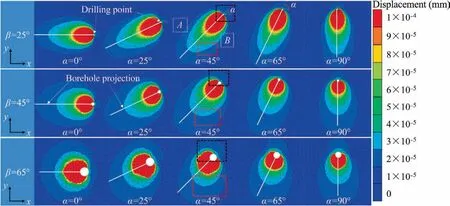
Fig.4.Nephograms of displacement of the upper surface of the 15 models at different drilling elevation angles.Note that the white solid lines indicate the projection of the borehole on the xy-plane.

Fig.5.Model displacements and the range of displacement exceeding 0.001 m.
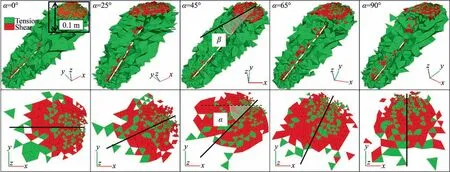
Fig.6.Plastic failure units in samples at β=25°.Note that the black solid lines denote the projection of the borehole on the xy-plane.
The relationship between the volumes of plastic zones and the azimuthal angle α was quantified.By programming a procedure for reading the volumes of plastic failure units by utilising the built-in FISH language of FLAC3D,the volumes of shear and tensile failure units after calculation of each model were computed.The statistical result is shown in Fig.7.As shown in Fig.7a,at β=25°,the volumes of shear failure units increased with the increase of azimuthal angle α,and reached a maximum (0.012 m3) at α=90°;at β=45° and 65°,the volumes of shear failure units showed no significant difference and were about 0.006 m3.Through the previous analysis,shear failure mainly occurred on the surfaces of the model and the borehole.At a small drilling elevation angle(β=25°),the borehole was closer to the upper surface of the model,so the volume of plastic failure near the surface of the model generated under the expansive pressure is much greater than that at a larger drilling elevation angle.That is,at a small drilling elevation angle,the shear failure units on the upper surface of the model constituted the main part of all shear failure units of the model,whereas the shear failure units were mainly found around the borehole at a large drilling elevation angle.Moreover,the horizontal stresses in the x-and y-directions were not equivalent,which exerted a more significant effect on the surface of the model than that on the interior of the model.Therefore,at β=25°,the volumes of shear failure units increased with azimuthal angle α;at β=45° and 65°,the volume was not significantly related to the change in azimuthal angle α.Compared with Fig.7b,the volumes of tensile failure units were far larger than that of shear failure units,so rock mainly underwent tensile failure when using SCDAs.It can be seen in Fig.7 that,for a certain drilling elevation angle β,the change in azimuthal angle α exhibited an insignificant influence on the volumes of tensile failure units.The mean volumes of tensile failure units at three drilling elevation angles β were 0.236,0.086,and 0.025 m3,respectively.The coefficient of variation k is defined as the ratio of the maximum volume to the minimum volume of failure units at different azimuthal angles,that is,
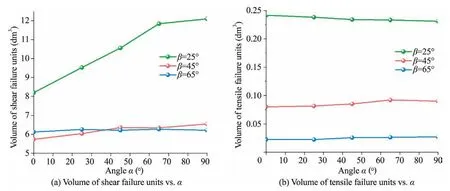
Fig.7.Volumes of shear and tensile failure units in the model.

where V is the volume of failure units.
The statistical result of coefficients of variation at different drilling elevation angles is displayed in Table 2.As shown in Table 2,the coefficient of variation of shear failure units was large only at β=25°(a change of 46%)otherwise the changes were all less than 15%.However,owing to the volumes of shear failure units being much lower than that of the tensile failure units,the azimuthal angle α did not significantly affect the efficacy of the SCDAs.
4.2.Effect of drilling elevation angle β on the efficacy of SCDAs
The angle β is generally referred to as drilling elevation angle.To explore the relationship between the elevation angle and the efficacy of SCDAs,the numerical model was still calculated by using FLAC3Dsoftware.In Section 4.1,it was found that the azimuthal angle α has no significant effect on the efficacy of the SCDAs.Therefore,azimuthal angles α was not taken into account,and only the models at α=0°were established.The drilling elevation angle of the model is set between 5° and 90° with an interval of 5°,so a total of 18 models are created.The model parameters were consistent with the aforementioned parameters.
Fig.8 shows slices of nephograms of displacement along the direction perpendicular to the y-direction.The dark blue area indicates that the displacement is less than 1×10-5m,and the red area indicates that the displacement is more than 1×10-4m.It can be seen that at β ≤20°,the rock masses(the range within the red dotted boxes)from the bottom of the borehole to the upper surface ofthe model were all influenced by the expansive pressure generated by the SCDAs.Owing to the upper surface of the model being a free boundary,the displacement of the model on the A side of the borehole was much greater than that on the B side.At β ≥30°,the range influenced by expansive pressure decreased.The reason for this is that the expansive pressure is applied towards the direction perpendicular to the wall of the borehole,so the distance to free surface at point P is h=ltanβ.With the increase of β,h increased rapidly as a tangent function.Therefore,the range of displacement rapidly declined.It can be seen in Fig.8 that for β ≥60°,the expansive stress only affected the edge of the borehole in the model,which implied that an excessively large drilling elevation angle was not conducive to efficient use of SCDAs.

Table 2 Coefficients of variation at different drilling elevation angles.
Fig.9 is drawn by combining the displacement contour of the upper surface of the model with the distribution of plastic zone.It can be seen that at β <60°,the displacement contour was quasi-elliptical with the major axis developing in the x-direction.With the increase of angle β,the major axis of the ellipse was gradually shortened,and the displacement contour was approximated to a circle at β=60°.For β >60°,the major axis continued to be shortened and became the minor axis of the ellipse.However,the change therein was significantly lower than that at β <60°.The reason for this is that under conditions that the borehole was nearly perpendicular,the effects of SCDAs on rock masses around the borehole were similar in various directions.In this context,the effects of different horizontal stresses in the x-and ydirections became prominent.Therefore,the displacement of the model in the y-direction gradually became larger than that in the x-direction because syyis lower than sxx.The range of the plastic zone in the upper surface of the model showed quite similar changes in shape to the displacement contour.Similarly,at about β=60°,the shape of plastic zones is about circular.In Fig.9,the length of the plastic zones is represented by ls.From the change of ls,it can be seen that the range of the plastic zone rapidly reduced with increasing drilling elevation angle.The relationship between β and lsis quantitatively analysed,as shown in Fig.10a.By fitting the data,it can be seen that with the growth of the elevation angle β,the length of the plastic zone decreased following an exponential trend,ls=2.79exp(-β/14.37)+0.08,with a fitting accuracy of R2=0.9932.This function reveals that the effect of the SCDA will rapidly decrease as the angle increases.
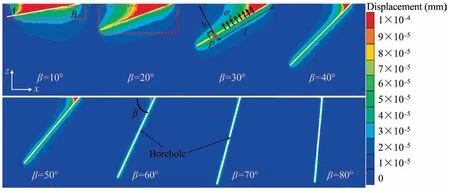
Fig.8.Nephograms of displacements at different drilling elevation angles.
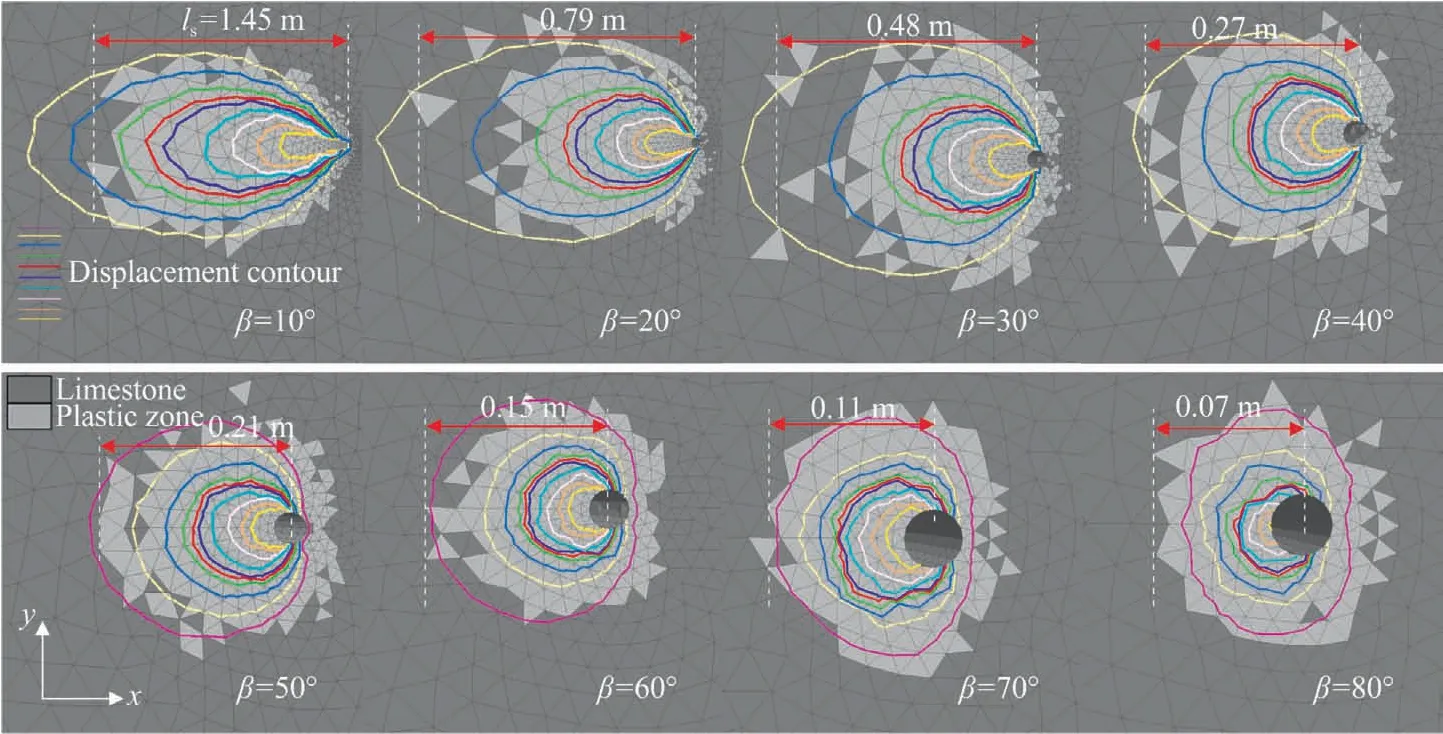
Fig.9.Displacement contours and plastic zones in various models.
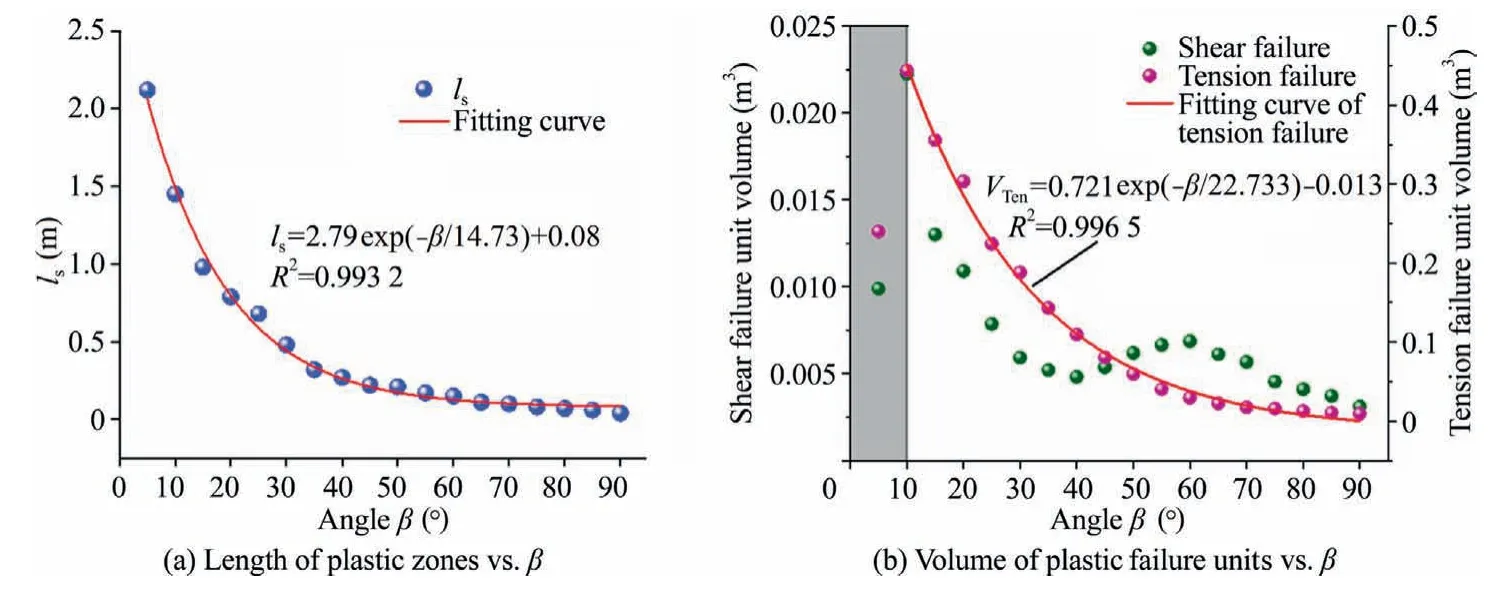
Fig.10.Relation between plastic zones and drilling elevation angle.
The volumes of plastic failure units were computed and the statistical results are shown in Fig.10b.When the drilling elevation angle is 5°,the volumes of plastic failure units(whether shear failure or tensile failure) are not the maximum.The reason is that at β=5°,the units from the bottom of the borehole to the surface of the model are all damaged.In this case,the volume of the plastic zones is restricted by the volume of rock rather than the effect of SCDAs.That is,the expansive pressure produced by SCDAs is not completely utilised and some is released from the upper surface of the model.At 10°<β <40°,the volumes of shear failure units gradually decrease while increase slightly at 40° <β <60°.For β >60°,the volumes of shear failure units decline again and reaches a minimum (0.003 m3) at β=90°.The volumes of tensile failure units exhibited an obvious change.By fitting the volumes of tensile failure units,in which the special condition of β=5° was not considered,it can be seen that with the increase of elevation angle,the volumes reduced exponentially as given by VTen=0.721exp(-β/22.733)-0.013.The volumes of tensile failure units decreased from 0.44 to 0.009 m3,implying that the lower the elevation angle is,the better the effect of SCDAs is.At β <60°,the volumes of tensile failure units are 6-32 times that of the shear failure units,which also indicates that rock is mainly subjected to tensile failure.Compared with the azimuthal angle,the drilling elevation angle shows a more significant influence on the effect of SCDAs.
4.3.Step-by-step weakening of the roof
At present,boreholes were generally drilled perpendicularly to the roofs in underground coal mines,which seriously restricts the effect of SCDAs.Through the aforementioned analysis,it can be found that the effect of SCDAs in the boreholes perpendicular to the roofs is far less significant than that in boreholes inclined to the roofs,especially when the elevation angle is less than 60°.Although the SCDA could function better when the inclination angle of the boreholes is shallow,its impact range at the direction of depth is small.Therefore,it is necessary to weaken the roofs step-by-step by utilising boreholes at different elevation angles.The weakened roof is likely to collapse under the influence of mining stress on the mining face.And the weakened roof is always kept 10 m ahead of the mining face to form a spatio-temporal coordination between weakening the roof and mining work.Therefore,the technical idea of ‘‘step-by-step weakening,spatio-temporal coordination,overall weakening”is proposed.And according to this idea,the boreholes at different angles are combined and arranged to form a group.Then,a ‘‘weakening unit”is established by combining two groups.
Based on the analysis in Sections 4.1 and 4.2,the effect of elevation angle β was far more significant than that of α.Thus,azimuthal angle α is not taken into account while only the distribution pattern of the elevation angle β is considered.The plastic failure units in the models with different drilling elevation angles β(Section 4.2)are extracted and the centres of the boreholes in each model are converged to a point.Therefore,one can clearly see the distribution of plastic zones at different drilling elevation angles(Fig.11a).The‘‘step-by-step weakening”of the roof can be achieved by combining multiple boreholes at different elevation angles.However,it is impossible to include more than a dozen holes in a weakening unit because drilling too many holes means time and labor consuming.If the drilling elevation angle is too low or too high,the effect of the SCDA cannot be fully exerted.Thus,the minimum and maximum elevation angles are selected as 20°and 60°,respectively.And a group including five boreholes in the same inclination which the angles are 20°,30°,40°,50° and 60°,respectively,is formed.The distance between two adjacent boreholes was set as ls,according to the length of plastic zones.From Fig.11a,it can be seen the smaller the angle β,the wider the plastic zone while the smaller the impact area of SCDAs in the height-direction.And the larger the angle β,the smaller the impact area along the width-direction.Therefore,reverse arrangement of the two groups of boreholes can achieve the complementarity of low-angle and high-angle boreholes,as shown in Fig.11b.The distance between two groups of boreholes was 0.5 m.In this way,a weakening unit(3.3 m × 1.3 m × 1.8 m) is formed.
5.Field application

Fig.11.Distribution of plastic zones.
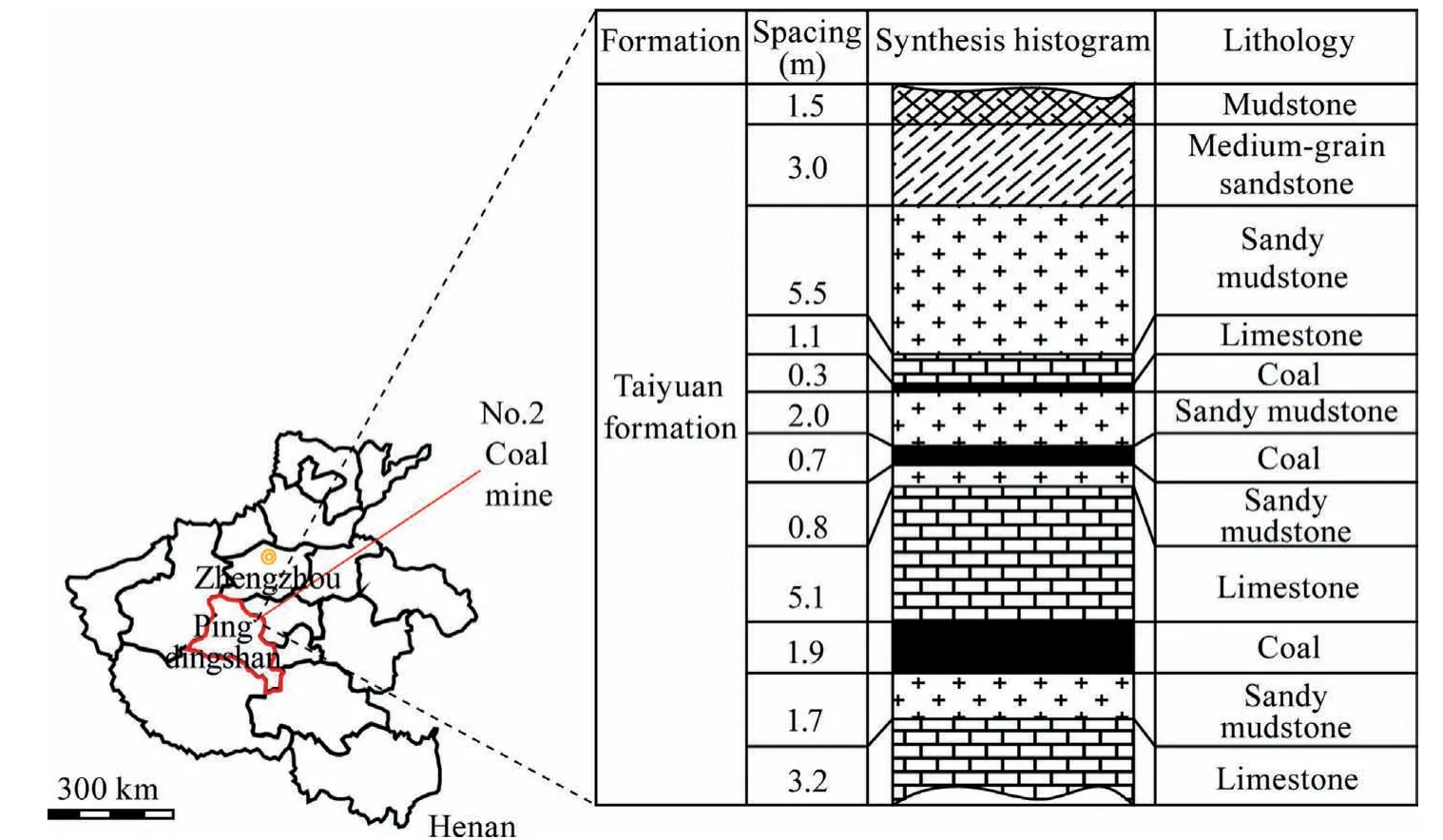
Fig.12.Location of field trial and composite columnar section.
The roof of coal seams in Pingdingshan mining area generally has the characteristics of large thickness,good integrity,strong bearing capacity,and poor fracture development.The immediate roof of the 21100 mining face in the No.2 coal mine of Pingdingshan Shares mainly exhibited grey thick-layer limestone,with grey sandstone in local zone,having a thickness of 5.1 m (Fig.12).The first and periodic caving spans of the main roof were 18-25 and 12 m,respectively.In the advance of the mining face,the immediate roof cannot spontaneously cave,thus forming a hanging block at corners,which adversely affected production safety.Boreholes are drilled in the roof of the air return roadway of the mining face.By using a borescope,it can be observed that the walls of boreholes are smooth and show no significant cracks,and the strata are intact layered rock masses.
According to the weakening unit analysed above,the air return and intake roadway of the 21100 mining face are observed.The weakening unit is located at 0.5 m away from the coal wall of the roadway and the length and diameter of the borehole are 2 and 0.04 m,respectively.Fig.13 shows the position of the weakening unit and a part of the underground boreholes.
The diameter and length of the SCDA cartridge are 0.038 and 0.15 m,respectively.Before being used,the reagent was immersed in water for about 2 min;afterwards,the reagent was taken out and backfilled into the borehole and tamped with a tamping rod.About 16 cartridges were placed into each borehole.After reacting for a day,the change in the roofs was observed.Fig.14 shows the weakening effect of SCDA on the roof.The destruction of the roof can be divided into three patterns i.e.fracture development,fracture connection,and rock falling.Cracks readily appeared in the rock mass around the borehole with a large drilling elevation angle.The direction of cracks showed no significant regularity.Fractures between the boreholes with a small drilling elevation angle were likely to become connected,which can greatly reduce the strength of the roof.Rocks were likely to be broken when being disturbed by drilling or having primary weak planes in the roof.However,some boreholes did not exhibit significant weakening characteristics because SCDA cartridges were not tightly tamped.Generally,SCDAs showed a remarkable weakening effect on the roofs and they can pre-split and weaken the roofs,which has obvious advantages in engineering applications.
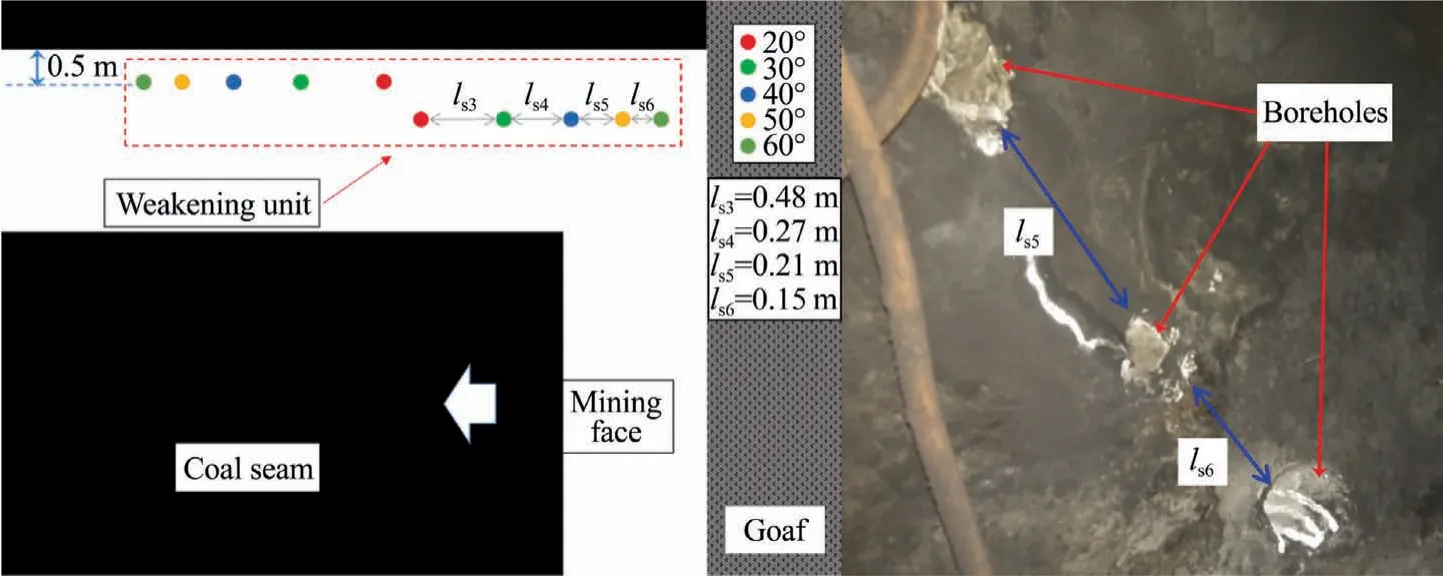
Fig.13.Position of the weakening unit on the roof.
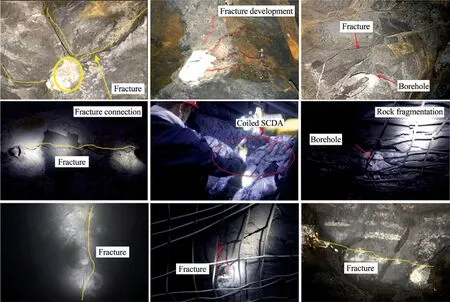
Fig.14.Field application of the method.
6.Conclusion
The usage of SCDA is becoming more and more extensive.However,there are few reports on its application in coal mines so far.Many problems such as the collapse of hard and thick roof,floor heave problems,and even coal seam cracking require artificial fracturing methods to ensure production safety in underground coal mines.Compared with hydraulic fracturing,blasting and others,SCDA has low manufacturing cost and high expansion pressure,and the reaction process is no-noise,dust-free,controllable,which indicates that SCDA is very suitable for coal mine applications and has a broad prospect.In this paper,FLAC3Dis used to analyse the weakening effect of SCDA on the hard roof.The main conclusions are as follows.
(1) The azimuthal angle (α) of the borehole has little influence on the effect of the SCDA.At different angle α,the deformation range,deformation magnitude,plastic failure range,and plastic failure volume of the model are basically the same.
(2) The drilling elevation angle (β) of the borehole has a significant influence on the effect of the SCDA,so the angle β is the main factor to fully exert the effect of SCDA.The displacement and plastic failure volume of the model decrease exponentially with the increase of angle β,which shows that the borehole perpendicular to the roof severely limits the effect of SCDA.
(3) Combining five boreholes with different drilling elevation angles into a group and arranging two groups in the opposite directions side by side,the ‘‘weakening unit”is established.High and low elevation angles of boreholes form spatial complementarity,which can not only effectively exert the effect of SCDA,but also realize pre-cracking of hard roof.
(4) Engineering application found that the roof under the action of SCDA mainly manifested into three failure forms i.e.fracture development,fracture connection,and rock falling.The field engineering verified the role of SCDA in the pre-cracked roof.
Acknowledgements
This work was financially supported by the National Key R&D Program of China(2020YFA0711800),the National Science Fund for Distinguished Young Scholars(51925404),the National Natural Science Foundation of China (51774278).
杂志排行
矿业科学技术学报的其它文章
- Development of ensemble learning models to evaluate the strength of coal-grout materials
- An updated empirical model for ground control in U.S.multiseam coal mines
- Study on seepage and deformation characteristics of coal microstructure by 3D reconstruction of CT images at high temperatures
- Drilling signals analysis for tricone bit condition monitoring
- Numerical assessment of the influence of former mining activities and plasticity of rock mass on deformations of terrain surface
- A hybrid tubular standing support for underground mines:Compressive behaviour
